|
Air Power |
The development of the Bell AH-1 "Huey" Cobra dates back to the 1960's when the need was recognized for a light fast armed escort helicopter designed specifically to carry weapons and be able to target them very accurately. The Cobra traces its lineage from the UH-1 Huey and was originally developed for the US Army in the mid-sixties. The original Cobra retained the Huey's engine, transmission, and other major parts, but replaced the Huey's bulky fuselage with a thin profile fuselage with tandem seating. Bell Helicopter (now Bell Helicopter Textron) had already evolved the first attack helicopter design, based on the use of UH-1 Huey dynamics (rotors, drives, engine) with a new fuselage. Bell also built a company-sponsored, scaled-down prototype using H-13/Model 47 series components, its Model 207 Sioux Scout.
The Lockheed AH-56A Cheyenne was designed to meet the US Army's requirement for the Advance Aerial Fire Support System (AAFSS), a program which began in 1964. Lockheed rolled-out the first prototype on 03 May 1967. While the Army went forward with its sophisticated AAFSS program to provide an attack helicopter, Bell proceeded with another company-sponsored prototype, Model 209, using the Huey dynamics and an airframe similar to the initial design. Bell Helicopter-Textron began design of the model 209 AH-1 "Huey" Cobra in 1965 as a successor to it's UH-1B/UH-1C "Huey" in the gun ship role. The result, incorporating the best features from the UH-1C "Huey", and many parts in common with the UH-1D, was the World's first attack helicopter. The 209 first flew in September 1965.
The Army wanted a small agile Advanced Attack Helicopter (AAH) with a less complicated fire control and navigation system than the AH-56A Cheyenne. The urgent need for greater armed helicopter performance in Vietnam and the success of the 209 led to Army orders for prototypes and production models of the 209 as interim attack helicopters, pending production of the AAFSS (which, finally, was never to occur). Carried over from the 209 were the slim fuselage with tandem cockpits (gunner in front of pilot), the Lycoming T-53 engine, stub wings with store stations and the under nose turret. Its retractable skid landing gear was replaced by a fixed gear. The Bell (model 209) AH-1G Cobra featured the new "540" wide-bladed rotor, and a slim fuselage, that gave it twice the speed of the UH-1B Huey. It could could loiter over the target area three times as long, and had an improved armament system over previous gun ships.
The decision to buy the Cobra, which was built primarily of Huey parts and thus a quick and relatively cheap development for Bell, created strong conflict within the Army between operators and material developers. At this time the material developers had spent years and huge amounts of money developing the advanced AH-56 Cheyenne attack and reconnaissance helicopter. After several months of discussion, the Chief of Staff of the Army called the director of Army Aviation and the Vice Chief of Staff of the Army into his office to settle the issue. He asked the director of Army Aviation Colonel George P. Seneff what the soldiers in Vietnam needed. Colonel Seneff told Chief of Staff General Harold K. Johnson and Vice Chief of Staff General Creighton Abrams that the soldiers were dying now, not in the future. They needed the Cobra. Partly based on their suggestion, General Johnson made the decision to buy the Cobra.
Bell Helicopter won the competition for an interim fast armed escort helicopter in March 1966, against the Sikorsky S-61 and the Kaman HH-2C Tomahawk. DOD contracted with Bell Helicopter, Inc. (BHI) for 1,100 AH-1G aircraft, which logged more than 1 million flight hours in Vietnam.
The original AH-1G prototype (Bell N209J) had fully retractable skids. Below is an interesting photo of N209J with a chin-mounted M197 20mm cannon, a TSU, and the TOW missile system. This is possibly a prototype of the armament subsystems that were being developed for the U.S. Marine Corps AH-1J or AH-1T configurations.
Based on his belief that Seneff accurately represented the needs of the soldiers on the ground and had a strong sense of loyalty and integrity, General Johnson also almost immediately sent Colonel Seneff to Vietnam as the first commander of the 1st Aviation Brigade. Immediately upon arriving in Vietnam, Seneff called in all aviation commanders and told them that the Army needed standardization for aviation, and that it would start right there, in Vietnam.
The AH-1G Cobra [or Snake] was first deployed to Vietnam in September 1967. The Cobra's primary mission was to give fire support to troop carrying Hueys. Its trial-by-fire introduction to service as the AH-1G in Vietnam immediately provided ground commanders with air superiority without the wait of calling in the Air Force. The narrow 38 inch wide airframe presented a much more difficult target than it's derivative, the 100 inch wide UH-1 "Huey". During the Vietnam War, the AH-1G Cobra was used extensively in a variety of missions ranging from armed escort and reconnaissance to fire suppression and aerial rocket artillery. The Cobra, or "Snake", was often used effectively when paired with an unarmed OH-6A Cayuse "Loach" or OH-58A Kiowa light observation helicopter or a UH-1H "Nighthawk".
During the early 1970s, the Army conducted a series of tests in Ansbach, Germany. The tests were to determine the suitability of air cavalry elements and the AH-1G Cobra, in particular, to operate in an antitank role in the European environment. These tests demonstrated that antiarmor helicopter teams, properly employed and trained, could achieve high ratios of armored vehicles destroyed for every missile-firing helicopter lost. Armed scout and attack helicopters--especially when operating in nap-of-the-earth and nighttime environments--clearly were shown to have the required survivability and to be viable and essential elements of conventional mid- to high-intensity warfare. Thus the way was paved for the development of the modern attack and scout helicopters and the doctrinal principles that would take Army aviation into the next century.
The AH-1G Cobra, or Snake, was armed with 2.75 inch (70mm) Folding Fin Aerial Rockets (FFARs) in M158 seven-tube or M200 19-tube rocket launchers, used so effectively at An Loc in 1972. The Cobra had a chin-turret on the M28/M28A1 armament subsystem. The chin-turret mounted the M134 7.62mm minigun and the M129 40mm grenade launcher. The AH-1G could also be armed with the M134 minigun in fixed side-mounting M18/M18A1 gun pod, and the port (left) side mounting M195 20mm automatic gun on the M35 armament subsystem. The AH-1G could also mount the XM118 smoke grenade dispenser.
Some early model AH-1G/AH-1Q Cobras mounted either two M134 miniguns or two M129 grenade launchers in a M28A1 chin-turret (TAT-141). Because of problems with the ammunition feed systems, the twin-gun configuration was discontinued. The Cobra was first employed to Vietnam with the 1st Cavalry Division (Airmobile) in August 1967. The Cobra's primary mission was to give fire support to troop carrying Hueys. The AH-1G/AH-1Q Cobras were powered by a single Lycoming T53-L-13 1400 shp turbine engine, and had a speed of 196 mph (170 knots), almost twice the speed of the UH-1 Huey. Both the AH-1G and AH-1Q Cobra used the M73 reflex sight. The Cobra performed it's job so well it was possible for the first time for Slicks and gun ships to operated as true air calvary.
The AH-1G was equipped with the CONFICS (Cobra Night Fire Control System) and the SMASH (Southeast Asia Multi-Sensor Armament Subsystem for Huey Cobra) systems to provide the Cobra with the capability of detecting, identifying, and targeting ground targets during day or night operations.
Specifications:
Contractor: Bell Helicopter TEXTRON, Inc. (Prime), General Electric, Kollsman Inc.
Power Plant: Two General Electric T700-GE-401 Turboshaft engines with 1,690 horsepower each.
Accommodations: Two seats, in tandem (pilot in rear, copilot/gunner in front)
Dimensions:
Main rotor diameter: 14.63 m
Tail rotor diameter: 02.97 m
Wing span: 03.28 m
Length: overall, rotors turning 17.68 m
Length: fuselage 13.87 m
Width overall: 03.28 m
Height: (to top of rotor head) 04.11 m
Performance :
Climb rate: 1,925 feet per minute
Maximum altitude: 14,750 feet
Maximum attainable speed: 170 knots (195 mph)
Maximum cruising speed: 152 knots (173 mph)
Range at S/L with standard fuel, no reserves: 317 nm
Armaments:
One M197 three barrel 20 mm gun (mounted under the nose with 750 round ammo container)
Underwing attachments for:
four TOW missiles, or
eight Hellfire missiles, or
one AIM-9L Sidewinder missile
Can also be equipped with Zuni rocket launchers
Countermeasures:
AN/ALE-39 Chaff system
SUU-4/1 Flare dispensers




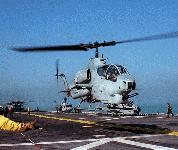
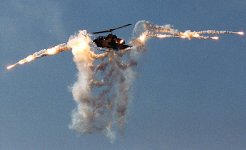
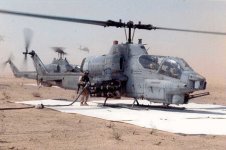
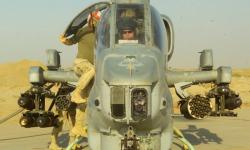
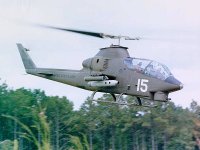
All photos Copyright of Global Security.org


